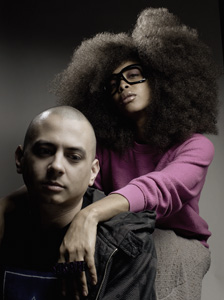
Link (via Gear Slutz)
Talking drums and tuning forks aside, what jumps out on first listen to New Amerykah is Badu’s multifaceted vocal approach. The queen of neo-soul is still in full force, cool and clever, but on tracks like Shafiq Husayn’s “Twinkle” and “Me,” Madlib’s “My People” and “Emotions” and Badu’s own “That Hump,” she scales high walls and makes you wonder, “How the heck did they do that?” Often, her layered harmonies sound purposely time-stretched or at least pitch-altered, so wide are the intervals she hits. But put it down to the gear used and her eclectic mic technique, not Electric Lady’s Pro Tools|HD3 trickery.
“I prefer a $37 Shure SM57 mic,” Badu reveals. “I have a very nasally voice. That mic has a lot of bottom in it. I put my mouth right up on it like an MC. I sit right in the control room between the two speakers next to the engineer, and I can hear what is going on very well. I used to have candles and incense in the studio, but I don’t require that now. I am in the mood all the time in the studio. I might do a vocal take 100 times and not get it, then come back the next day at 3 a.m., and laying down on the floor, my ears will get it. Pitch is good but feeling is better. I never cut and paste or punch in, I like a single vocal take.
“When I do vocals, I am singing with a certain volume in my voice,” she adds. “I am singing the double and triple harmonies at different volumes. You don’t have to adjust it; I have already done it. We mix as we go, so by the time we put the vocals to ½-inch tape, I know it. If you touch a damn thing, I will know it.”
Badu prefers to cut her vocals in the control room with the monitor mix blasting over her head as she sings. That obviously presents leakage problems for Chav, but he has developed ways to work around her methods while also getting a usable take. Sometimes Badu would sit in an overstuffed chair about six feet behind the SL 9000 J board, alternately using a Neumann M 269, Shure SM57 or AEA R44 ribbon mic with Sony MDR-V900 headphones into a Furman headphone mixer. But she was just as likely to discard the headphones and sing right into the studio’s Adam Professional Audio S3A studio monitors.
“There’s not any feedback there when you do that, but there is a fair amount of leakage,” Chav explains. “We worked to make her vocals fit into the track, phase-wise. I asked a lot of people how to do this. They said, ‘Sit her in an equilateral triangle with the speakers, putting one of the speakers out of phase, so the leakage should cancel itself.’ But to do that, the mic has to be stationary, and she likes to hold the mic like an MC. She is at home as a live performer. What did work was to keep the monitors fairly low and turn the microphone out of phase, and we would move her around the room until she found a spot where the leakage was reasonable and where she felt comfortable and could hear herself. But just as often she would just sit in that chair behind the board in the A Room.
“Her voice has so many frequencies,” Chav continues, “from a subharmonic of her tonic to a thin raspiness, and she wants to hear all of that. And she couldn’t hear all of that in the headphones. I tried to get her a pair of $3,000 Stax phones, but the label didn’t go for that



